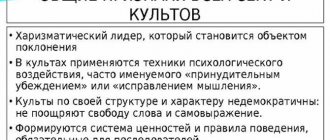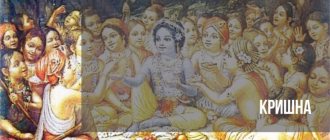Increasingly, information appears in the media about the emergence in Russia and Ukraine of all sorts of sects and pseudo-religious organizations, aimed primarily at young people. Moreover, this phenomenon is spreading mainly in the regions. Why have sects become active again? How dangerous is sectarianism? Are there legislative ways to combat this phenomenon in Russia? And how are sects connected with the Maidan technologies of the color revolutions?
Let's try to understand this phenomenon, as well as the impact they have on society.
Let’s start with the concept itself, let’s try to understand what a sect is.
The diversity of religious new formations is so great that there was a need for a common name for them. Neither in Russia nor abroad there is a consensus regarding their terminological designation. They are called differently: sects, non-traditional religions, new religious associations, alternative beliefs, emerging religions or simply cults, New Age - New Time Religions, etc. The lack of a terminological apparatus led to the fact that everyone began to interpret these concepts at their own discretion, based on their ideological position.
Concept of sect
in Russian it is used in two meanings, historically related, but significantly different. However, these meanings are not always clearly distinguished, and the negative connotation inherent in one of the meanings (“totalitarian sect”) is transferred to sects as a whole. It should be remembered that this word, as a rule, does not denote the teaching itself, but the organization representing it.
In most cases, religious organizations do not welcome the use of the term sect in relation to them, preferring to be called a religion, church, confession or denomination. The very word “sect”
- not neutral, it contains a deep historically determined subtext and in Russian often has a derogatory connotation. Indirect confirmation of this are the words “sectarian”, “sectarianism” and “sectarian” derived from this term, which cause negative associations and are usually used polemically or pejoratively.
Already in Latin the word secta
had the following meanings:
- way, rule, way of action, thought or life;
- teaching, direction, school;
- heresy, false teaching;
- gang;
Etymologically, the word sect comes from Lat. secta from sequī
- “to follow someone, obey”;
Moreover, quite early this word became associated with the word Lat. sector
and other derivatives of
seco
- “cut, divide, cut off.”
The word "sect" was originally a neutral term to describe individual political, philosophical and religious groups, and was used in a polemical context even in the pre-Christian era.
Already in the early Christian era, it began to designate a false teaching that broke away from the main community, being used to translate ancient Greek. αἱρέϭις
(which also at first simply meant “teaching, school, direction”, and then narrowed to the concept of “false teaching, heresy”). These two words were used as synonyms in the Latin West until modern times.
After the Reformation, a distinction was made between the meanings of the terms: the word “ sect”
" began to denote an organization or group of people, and "
heresy
" is an unorthodox teaching contained by a sect or denomination, and this rule of usage was also addressed to the past of Christianity (thus, one can say, for example, that the Severian sect professed the Monophysite heresy).
This distinction between these concepts was adopted by Russian theological science during the synodal period in the history of the Russian Orthodox Church. In Greek theology, until today, only the word αἱρέϭις is used in both meanings.
According to the Explanatory Dictionary of the Russian Language edited by S.I. Ozhegov and N.Yu. Shvedov, a sect is:
- A religious movement (community) that has separated from some creed and is opposed to it.
- trans. A group of people isolated in their own petty, narrow interests (book disapproved).
The term is not sufficiently defined, since it does not highlight characteristic internal features, only external ones, if we talk about the first meaning, and the second meaning includes any group united by some interests, be it a family, a party, a corporation or a state.
The term sect is used in Recommendation of the Parliamentary Assembly of the Council of Europe of 1994 No. 1178 “Sects and new religious movements”, where it is not defined. The same term appears in the official diplomatic document of the German Embassy - note verbale of the Russian Foreign Ministry dated November 22, 1995 No. 2604. France adopted the Law of May 30, 2001 “On the prevention and prevention of sectarian movements that infringe on fundamental human rights and freedoms.” Considering its demands, the Parliamentary Assembly of the Council of Europe also uses the term “sect” in Resolution No. 1309 “Religious freedom and religious minorities in France”, adopted on November 18, 2002.
The term "totalitarian sects"
contained in the signed V.V. Putin’s “Russian Information Security Doctrine”, which, in particular, talks about:
the need to counter the negative influence of foreign religious organizations and missionaries
And as posing the greatest danger to the spiritual life of citizens, the following are indicated:
causing harm to the health and life of citizens as a result of the activities of religious associations preaching religious fundamentalism, as well as totalitarian religious sects (Putin V.V. Doctrine of Information Security of Russia https://www.scrf.gov.ru/documents/6/5.html) .
A certain stage in the dispute over the use of the non-legal term “sect” was the decision of November 23, 1999 of the Constitutional Court of the Russian Federation, which confirmed the possibility of its use and thus introduced it into legal practice. In connection with complaints from the Religious Society of Jehovah's Witnesses in the city of Yaroslavl and the religious association "Christian Church of Glorification", the Constitutional Court stated that the information reported by the media about Jehovah's Witnesses was true. Having studied extracts from dictionaries and encyclopedias, the Court also came to the conclusion that the concept of “sect” used in the newspaper and television program is well known and is used in relation to religious organizations professing the views of a narrow group of people compared to the overwhelming majority. Consequently, it cannot offend anyone’s feelings (Resolution of the Constitutional Court of the Russian Federation of September 26, 1997 No. 16-P In the case of checking the constitutionality of paragraphs of the third and fourth paragraph 3 of Article 27 of the Federal Law 125-FZ “On Freedom of Conscience and Religious Associations” » https://www.medialaw.ru/article10/7/5-4.htm).
Thus, judicial practice in the Russian Federation proceeds from the admissibility of the term sect and considers it as completely legitimate.
The above documents show that the absence of the concept of “sect” in Russian regulatory documents does not at all limit the possibility of its use in legal practice. Based on the ruling of the Constitutional Court, it is necessary to develop a systematic set of legal provisions regulating the activities of such a dangerous phenomenon of modern social life as sects. And, first of all, in modern Russian legislation it is necessary to formulate meaningfully and evaluate the concept of sect.
However, the absence of a meaningful legal definition of a sect in general and a “totalitarian” sect in particular makes it possible to label anyone as a sect and sectarians. This is very convenient for implementing the principle “the law is what the drawbar is: where you turn, that’s where it goes.” However, if you think that a professor of religious studies should be quite capable, the definition of a sect can be given without resorting to the practice of legalized arbitrariness with its subsequent analysis. Therefore, scientists have given a definition of the concept of “sect” containing the characteristic features of the phenomenon, reflecting its inner essence, and not external signs, such as “a teaching separated from some creed,” “a group closed in their own petty, narrow interests.”
At least five characteristic features are common to all sects without exception, regardless of their age and number of participants:
- The presence of esoteric and exoteric teaching , which in Russian means: in a sect there is always a teaching for the crowd and a teaching for the elite - dedicated hierarchs.
- The presence of certain dogmas of the doctrine , which are not subject to discussion and must be accepted by adherents of the doctrine as true without any doubts or reasoning.
- The presence of a ritual that accompanies every meeting of representatives of the sect and is actually a means of zombifying their psyche.
- The existence of an arbitrarily branched hierarchy , entering into a dispute with which according to the basic tenets of the teachings of the sect is strictly prohibited.
- is no and cannot be room in it (there is no method of mastering it) and a meaningful attitude towards Life according to conscience.
But this definition is unlikely to please a religious studies professor, since historically established confessions appear on the basis of this definition as the most numerous sects (in the sense that they cut off the believer of the sect from God, replacing living religion - as a dialogue between man and God in life - with ritual belief and dogmatism), which have long occupied a dominant position in societies and therefore have become common attributes of traditional culture.
Those associations of people that traditional confessions call “sects” are, for the most part, the same sects as they are, but have not managed to gain legitimacy in the culture of society.
Let us describe these five main signs in more detail and add some indirect signs, accompanying everything with specific examples:
Features of the use of the concept[edit]
Concept of sect
in Russian it is used in two meanings, historically related, but significantly different. However, these meanings are not always clearly distinguished, and the negative connotation inherent in one of the meanings (“totalitarian sect”) is transferred to sects as a whole. It should be remembered that this word, as a rule, does not denote the teaching itself, but the organization representing it.
In most cases, religious organizations do not welcome the use of the term “sect” in relation to them, preferring to be called a religion, church, confession or denomination. The very word “sect”
– not neutral, it contains a deep historically determined subtext and in Russian often has a derogatory connotation. Indirect confirmation of this are the words “sectarian”, “sectarianism” and “sectarian” derived from this term, which cause negative associations and are usually used polemically or pejoratively.
Trials
In April 1995, almost the entire leadership of the sect was arrested. The trial began in 1996. On February 27, 2004, the Tokyo District Court sentenced Shoko Asahara to death by hanging, finding him guilty of 13 of 17 charges (murder of 27 people, kidnapping, illegal production of weapons, etc.). Subsequently, 189 members of the sect received various prison sentences, 10 of them were sentenced to death. In 2012, the last of the hiding organizers of the terrorist attack on the Tokyo subway, Katsuya Takahashi, was arrested. He was sentenced to life imprisonment.
Origin of the concept[edit]
Already in Latin the word secta
had the following meanings:
- way, rule, way of action, thought or life;
- teaching, direction, school;
- heresy, false teaching;
- gang;
Etymologically, the word sect comes from Lat. secta from sequī - “to follow someone, obey”; Moreover, quite early this word became associated with the word Lat. sector and other derivatives of seco - “cut, divide, cut off.”
The word "sect" was originally a neutral term to describe individual political, philosophical and religious groups, and was used in a polemical context even in the pre-Christian era.
Already in the early Christian era, it began to designate a false teaching that broke away from the main community, being used to translate ancient Greek. αἱρέϭις (which also at first simply meant “teaching, school, direction”, and then narrowed to the concept of “false teaching, heresy”). These two words were used as synonyms in the Latin West until modern times.
After the Reformation, a distinction was made between the meanings of the terms: the word – “ sect”
” began to denote an organization or group of people, and “
heresy
” is an unorthodox teaching contained by a sect or denomination, and this rule of usage was also addressed to the past of Christianity (thus, one can say, for example, that the Severian sect professed the Monophysite heresy). Such a distinction between these concepts was adopted by Russian theological science during the synodal period in the history of the Russian Orthodox Church. In Greek theology, until today, only the word αἱρέϭις is used in both meanings.
Differences from other types of religious organizations[edit]
In the (English-language) typology of church organizations, a sect is contrasted with a denomination and a church. See more about this in English. article Church-sect typology. At the same time, in the Russian language, the concept of denomination is more often used as a general word for any divisions within a particular religion (including sects and churches), and churches usually refer to the main traditional denominations (the Orthodox Church and individual autocephalous churches, the Catholic Church, ancient Eastern churches , Anglican Church and some others).
Main features[edit]
Main feature
sects compared to other religious organizations is its
young age
. As a rule, over time, sects either disappear or turn into full-fledged denominations or separate religions. The concept of “sect” is rarely applied to religious organizations that have existed for more than 100-200 years.
At the same time, we must remember that such a division is characteristic primarily of Christianity, outside of which the concept of church
, as a rule, is not used.
Doctrinal features
: Sects are characterized by a more or less pronounced doctrinal conflict with the original confession; they consider themselves as the only sure way to salvation. Also, sects (especially those that arose within Christianity) are characterized by accusations of the original confession of distorting the doctrine and calls for a return to the original sources. Various groups that emerged from Orthodoxy in the 17th-18th centuries. (Dukhobors, Molokans, Skoptsy, Khlysty, etc.) are called sects because they reject many doctrinal provisions of Orthodoxy, while at the same time, individual autocephalous Orthodox Churches and even non-canonical Orthodox jurisdictions are never called sects, since they doctrinally do not differ in any way from other Orthodox churches.
Temporary compactness and the presence of an outstanding leader
: if Christianity itself arose as a sect within the framework of the Old Testament religion (see, for example, the words of the high priest Ananias about the Apostle Paul: “
Having found this man ... a representative of the Nazarite heresy
” (in other translations -
sects
) Acts 24:5), then the main Christian trends cannot be called sects, since they were usually formed over a long period of time (although the formal division can often be precisely localized in time), rather than being formed over a few years around a specific leader.
The same applies to autocephalous Orthodox churches and independent ancient Eastern churches. At the same time, many Protestant denominations arose precisely as sects (Baptism, Methodism, Mennonism, Quakers), so this term has long been used in relation to many or even all Protestant movements (but not to Protestantism itself as a whole).
Relationship between the sect and the original religious organization[edit]
There are several options for the development of the relationship between the sect and the original religion:
- The sect considers itself part of the original religion, which is recognized by the rest of that religion -
- A sect considers itself part of an original religion, but this is rejected by the rest of that religion (usually based on serious doctrinal differences) - for example, Mormons consider themselves Christians, but are not recognized as such by other Christian denominations
. - The sect is only connected by origin with the original religion, but is considered a separate religion - for example, Baha'is
. - The sect initially arose independently of other religions or based on a combination of elements of different religions
Kirillova K. About the term “sect”
Ksenia Kirillova, 2006
About the term “sect”
1. How did the term “sect” and its derivatives come about?
The term "sect" comes from the Latin word "sekta" and originally had two etymologies:
a) part of something;
b) way of thinking, teaching.
Accordingly, derivatives from the word “sekta” in Latin are “secare” - “to cut off” (a part from the whole) and “sequi” - “to follow” (to follow someone in doctrine, way of thinking).
In the Russian language, the concept of “sect” and derivatives from it began to be used since the introduction of Latin language teaching courses in theological seminaries and academies, secular gymnasiums, lyceums and universities. At the same time, the words retained their original phonetic pronunciation and semantic meaning. The use of the term “sect” to mean “part of something” led to the appearance of the well-known words “sector” and “section” today. The use of the term “sect” to denote “way of thinking, teaching” gradually transformed into the name of one of the institutional types of religious associations.
2. What does the term “sect” mean?
I will give definitions from authoritative sources.
“The Explanatory Dictionary of the Living Great Russian Language” by Vladimir Dahl reports: “A sect is a brotherhood that has accepted its own, separate teaching about faith; agreement, understanding, schism or heresy”[1].
In the “Dictionary of the Russian Language” by S.I. Ozhogov , a sect is defined as “a religious association that has separated from any teaching and is opposed to it,” and in a figurative sense - as “a group of people isolated in their own petty, narrow interests”[2] . The same interpretation is given to the term by the “Encyclopedia of Cyril and Methodius”[3].
Ushakov ’s academic “Dictionary” understands a sect as “a religious community consisting of people who broke away from the dominant church and accepted a new teaching,” and in a figurative sense – “a group of people who have fenced themselves off from communication with others, who have withdrawn into themselves”[4].
This term is explained in a similar way in the Dictionary of Foreign Words, edited by F.N. Petrov : “A sect is a religious community that has broken away from the dominant church; a closed group alienated from the wider masses.”
Thus, it can be noted that at the time of preparation of the above sources, the term was used to designate both specific religious associations and simply closed groups that distanced themselves from society due to their own, not necessarily religious, interests.
It was in this “double” meaning that the word “sect” was previously used.
In the interpretation of “a closed group alienated from the broad masses,” the term was usually applied to small political organizations of an oppositional nature.
A typical example is the “Manifesto of the Communist Party” prepared by K. Marx and F. Engels , where it is noted that groups of adherents of social utopias “have degenerated into the purest sects,” and the communists themselves do not share such “sectarian principles”[5]. These same authors, in the pages of their joint work “Imaginary Schisms in the International,” wrote about “sectarian sections,” “sectarian groups,” and “sectarian organizations,” meaning by them small political circles with alternative views[6]. In the introductory article to the English edition of “The Development of Socialism from Utopia to Science,” Engels reported that the German scientist E. Dühring “openly began to create a sect around himself, the core of a future special party”[7], in a letter to August Babel he called the utopian socialists “inveterate sectarians”[8], and in the article “Marx and the Neue Rheinische Zeitung” he emphasized that without understanding the role of the proletariat, German Social Democrats could “found a small sect instead of a large party of action.”[9] Karl Marx in a letter to Friedrich Bolte also about[10].
To be fair, it should be noted that opponents of communist ideas also willingly used the term “sect” in relation to their opponents. The famous Russian artist of the “Silver Age” Maria Bashkirtseva wrote in her diary on July 17, 1874: “They say that in Russia there is a gang of scoundrels who are seeking a commune; this is such a horror! And their vile sect is so widespread that magazines make desperate appeals to society.”[11]
The concept of “sect” was no less actively used to designate “religious communities that broke away from the dominant church.” Sergius Bulgakov, published in 1912, “Orthodoxy. Schisms. Heresies. Sects”[12] or the article by the famous writer Nikolai Leskov “A few words about the Doukhobor and other sects”[13]. Nikolai Berdyaev wrote about “sectarians”, “Russian sectarianism”, “sectarian religious literature”, “sectarian pathos” in relation to national culture on the pages of the work “Types of Religious Thought in Russia”[14]. Vladimir Bonch-Bruevich, one of the most famous pre-revolutionary researchers of religion, was the compiler of the multi-volume “Materials for the history and study of Russian sectarianism and Old Believers,” the books of which were published from 1908 to 1916[15].
In addition, in Tsarist Russia this term was widely used in legal acts regulating religious activity. “Passports for absences within the Empire are issued to schismatics of all sects,” it was noted, for example, in the opinion of the State Council “On the granting of certain civil rights to schismatics and for the administration of spiritual duties,” published in 1883 [16], and published in 1911 “ The Code of Civil Laws" contained a section "On the metrical recording of marriages of Old Believers and sectarians"[17].
After 1917, the word “sect” began to disappear from the “political” lexicon, and its concept was narrowed to designate one of the types of religious associations. In this capacity, it was used with equal success both by authors of popular science literature (for example: Privalov K. B. Sects: dossier of fear. M., 1987), and by serious scientists (for example: Klibanov A. I. Religious sectarianism in past and present. M., 1973; Moskalenko A. G. Ideology and activities of Christian sects. Novosibirsk, 1978, Klyueva T. A. Christian sectarianism in urbanization. M., 1980).
Currently, scientific literature gives the following definition to a sect: “A religious sect (Latin secta - way of thinking, teaching) is one of the types of religious associations. A religious sect arises as an opposition movement in relation to one or another religious movement. A religious sect is characterized by a claim to the exclusivity of its role, doctrine, ideological principles, values, and attitudes. Associated with this are sentiments of selectivity, and often a tendency towards isolationism. The desire for spiritual expression (revivalism) is sharply expressed, a sign of which is considered to be strict adherence to a certain moral code and ritual instructions. This attitude often leads to fanaticism. The religious sect denies the institution of the priesthood, considers leadership to be charismatic, and recognizes the right to it for a person who has supposedly received, as the grace of God, a special ability to lead. The equality of all members is emphasized, the principle of voluntary association is proclaimed, and emphasis is placed on the “conversion” that precedes membership. The indicated features, taken separately, can be found in religious associations of other types. However, the set of characteristics is characteristic of a religious sect. General characteristics are modified in different ways in different sectarian movements. The historical fate of religious sects is not the same. Some of them cease to exist after a certain period of time. Others become churches or denominations over time.”
This definition is academic - since it is contained both in the “Atheistic Dictionary” of the Soviet era[18] and on the pages of the textbook “Religious Studies” , published in 1998 under the editorship of Professor, Doctor of Philosophy, Head of the Department of Philosophy of Religion and Religious Studies of Moscow State University, member of the Council to conduct a state religious studies examination under the Ministry of Justice of the Russian Federation I.N. Yablokov[19].
The term “sect” itself in this understanding continues to be widely used by scientists. Only in recent years have such works been published, for example: Braslavsky L.Yu. “Protestant sects in Chuvashia” (Cheboksary: Book publishing house, 1988. - 96 p.); A. Novopashin. “Religions and sects in modern Russia” (Novosibirsk, Publishing House of the Temple in the Name of A. Nevsky, 1998); Panchenko A.A. “Christianity and Skoptchestvo: folklore and traditional culture of Russian mystical sects” (OGI Publishing House, 2002. - 543 pp.); Taevsky D.A. "Christian heresies and sects of the 1st - 21st centuries: Dictionary." (Published “Intrada”, 2003. - 320 p.)
In addition, the concept of “sect” and its derivatives were widely used by the authors of many other scientific works, for example: V.I. Garadzha . “Religious studies. Textbook for students of higher educational institutions and teachers of secondary schools" (2nd edition, supplemented. Moscow, "Aspect Press", 1995); A.V.Fedoseev . “Fundamentals of Religious Studies. Methodological manual" (Donetsk, publishing house of the Donetsk State Academy of Management, 1997); Omurova T.O., Lukashov V.A. “Religious Studies. Educational and methodological manual" (Bishkek, 1998); I.N. Yablokov. “Religious studies. Textbook and minimum educational dictionary for religious studies" (M.: Gardarika, 1998); E.G. Balagushkin. “Non-traditional religions in modern Russia” (Moscow, 1999); N.A. Trofimchuk, M.P. Svishchev. “Expansion” (Moscow, Publishing House of the Russian Academy of Public Administration under the President of the Russian Federation, 2000).
Thus, the term "sect" continues to be widely used in scientific circles.
3. Do the terms “sect” and “sectarian” have a negative connotation?
As can be seen from the above, the terms “sect” and “sectarian” (sect member) do not carry a negative semantic connotation. In the scientific world and among believers of traditional religions, a sect means only one of the types of religious associations, and a sectarian is understood as a person who sympathizes with the teachings of a sect, who shares the views of a sect as a certain type of religious association. These terms have neither negative nor positive meaning.
Of course, every person, based on the baggage of his ideas about the world around him, his inherent beliefs and characteristics of self-esteem, may consider this or that neutral concept offensive. However, based on a subjective assessment, this concept cannot be declared to detract from the honor, dignity or business reputation of a citizen.
It should be noted that even Western countries known for their tolerance, in which the cult of respect for a person’s personality and his religious choice flourishes, do not see anything reprehensible in the use of the term “sect”.
In 1994, for example, the Council of Europe approved recommendation No. 1178 “On sects and new religious movements.” The same term was used by the German Embassy in an official diplomatic document - note verbale No. 2604 dated November 22, 1995, addressed to the Russian Foreign Ministry. The Resolution “On Sects in Europe” was adopted on February 12, 1996 by the European Parliament. “On the prevention and prevention of sectarian movements that infringe fundamental human rights and freedoms” is the name of the law approved on May 30, 2001 in France . Considering its demands, the Parliamentary Assembly of the Council of Europe, in Resolution No. 1309 (2002) “Religious freedom and religious minorities in France” adopted on November 18, 2002, also uses the term “sect”.
Russian government agencies use it just as willingly. The concept of “sect” was used at different times by the Ministry of Health and Medical Industry of the Russian Federation in the attached Letter No. 2510/3774-96-27 of August 21, 1996, “Information material on the socio-medical consequences of the influence of certain religious organizations on the health of the individual, family, and society.” and measures to provide assistance to victims,” the Ministry of Internal Affairs of the Russian Federation in the certificate “On the activities of some foreign religious organizations in Russia” attached to letter No. 1/17464 of October 23, 1996 to the State Duma of the Russian Federation, and the Ministry of Education of the Russian Federation in attached to letter No. 549 /28-16 dated July 12, 2000 “Information on the activities of representatives of non-traditional religious associations on the territory of Russia.”
The same concept was repeatedly used in official speeches by the first President of Russia, Boris Yeltsin . It is truly necessary, it must protect the moral and spiritual health of Russians, put up reliable barriers to the penetration of radical sects that cause great damage to the health and psyche of the citizens of our country.”[20] In addition, this term was used at various times in their public speeches by the head of the department for relations with religious and public organizations of the Government of the Russian Federation, Genrikh Mikhailov[21], the Minister of Internal Affairs of the Russian Federation, Vladimir Rushailo[22], and the head of the Department for Internal Policy of the Presidential Administration Russia, executive secretary of the Council for Interaction with Religious Organizations under the President of the Russian Federation Andrey Loginov,[23] Academician of the Russian Academy of Sciences Eduard Kruglyakov[24], head of the department of interdepartmental and information activities of the Federal Service for Drug Control Alexander Mikhailov[25], Deputy Prime Minister of the Russian Federation Valentina Matvienko[26], Chairman of the Russian State Duma Committee on International Affairs, and now Commissioner for Human Rights in the Russian Federation Vladimir Lukin[27], Moscow City Prosecutor Yuri Semin[28], Plenipotentiary Representative of the President of Russia in the Central Federal District Georgy Poltavchenko[29 ], Vice-Speaker of the State Duma of the Russian Federation Oleg Morozov[30], Chairman of the Federation Council Sergei Mironov[31], Director of the FSB of Russia Nikolai Patrushev[32] and many other respected people holding prominent government positions.
Finally, there are cases when the term “sect” and derivatives from it were used by Russian judicial authorities . Thus, this concept was used by the Khoroshevsky Intermunicipal People's Court of the North-West Administrative District of Moscow in a decision dated May 21, 1997 (case 2-1208) on the claim of the Public Committee for the Defense of Freedom of Conscience, Lev Semenovich Levinson, Mikhail Semenovich Osadchev and Natalya Aleksandrovna Balukova against Alexander Leonidovich Dvorkin and Department of Religious Education and Catechesis of the Moscow Patriarchate.
The same term was used by the Constitutional Court of the Russian Federation in Resolution No. 16-P of November 23, 1999 in the case of verifying the constitutionality of paragraphs three and four of paragraph 3 of Article 27 of the Federal Law of September 26, 1997 “On Freedom of Conscience and Religious Associations.” He, in particular, in his decision about.
From the above, we can conclude that a huge number of official authorities and responsible government officials do not see anything reprehensible in the use of the term “sect” and its derivatives.
4. Is it possible to use the term “sect” and its derivatives from the point of view of current Russian legislation?
The Federal Law “On Freedom of Conscience and Religious Associations” adopted in 1997 does not use the term “sect”. From this, some opponents of the concept jump to the conclusion that the word “sect” is “illegal” and offensive.
This opinion is erroneous, since the legislator is not obliged to mention in legal acts all terms derived from these terms, synonyms, etc., related to a particular phenomenon - for example, religious activity. In the same federal law “On Freedom of Conscience and on Religious Associations” there is no mention, and, moreover, no definitions of such concepts as “church”, “priest”, “parishioner” that are well-established in the mass consciousness. However, this does not mean that the Russian Orthodox Church with priests and parishioners “does not exist,” or that these terms are abusive, belittling someone’s honor, dignity and business reputation.
The situation is similar with the word “sect” and its derivatives. In fact, mention of this term is unnecessary. The legislator operates with the extremely broad category of “religious association”, taking into account the fact that in classical religious studies all religious associations are usually divided into three institutional types:
A) Sect
B) Denomination
In church.
Consequently, despite the absence of references to the types of religious associations in the legislation, there is no reason to consider the term “sect” and its derivatives to be contrary to this legislation.
5. Are there any cases of litigation in Russia on claims where one of the parties equated the use of the term “sect” or its derivatives with an insult to their honor, dignity and business reputation? If there are such precedents, what decisions were made?
To date, three such “high-profile” cases are known - and in all three the courts refused, following one of the parties, to consider the term “sect” and its derivatives offensive.
Thus, the Dzerzhinsky Federal Court of the Central District of St. Petersburg in a decision dated August 4, 1999 (case No. 2-237) on the claim of M.E. Slobodyan against the editors of the newspaper “New Petersburg”, V.A. Ageeva and E.E. .Terentyev on the protection of honor, dignity and business reputation noted the following:
“The plaintiff claims that the use of the words “sect” and “sectarians” in relation to the organization of which she is a member insults her feelings and discredits her honor and dignity. At the same time, the court was presented with extracts from various dictionaries and encyclopedias (case sheets 101-102, 128-133), from which it follows that the word “sect” as a concept is well known and is used in relation to religious organizations that profess rather a narrow group of people compared to the vast majority. Therefore, the use of the word “sect” cannot offend anyone’s feelings.”
As a result, the plaintiff’s claim was denied[33].
Kuznetsk District Court of Novokuznetsk, Kemerovo Region in a decision dated June 6, 2001 on the claims of the Church of Christians of the Evangelical Faith "Living Water" of the Association of Independent Churches of Christians of the Evangelical Faith of Novokuznetsk, the Church of Christians of the Evangelical Faith "Living Water" of the Association of Independent Churches of Christians of the Evangelical Faith of the city Myski to the rector of the Transfiguration Cathedral, Vladimir Aleksandrovich Pivovarov, regarding the protection of honor, dignity and business reputation, reported that the plaintiffs asked “to take measures of influence against the Orthodox priest V. A. Pivovarov, who, speaking on March 17, 2001 on the TV channel TRC “Apex” ", made incorrect statements about the church, in particular: the Living Water Church was called a "dangerous totalitarian sect", they consider this statement as an insult to the honor and dignity of about 1000 parishioners of the Living Water Church. However, the court itself came to the following conclusion: “The concept of “sect” used is well known and is used in relation to religious organizations professing the views of a narrow group of people compared to the overwhelming majority. Therefore, the use of the word “sect,” according to the court, cannot offend anyone’s feelings. The phrase “totalitarian sect” is a scientific and journalistic term that reflects the attitude of a particular person to a particular religious organization. By filing a lawsuit, the plaintiffs are trying to force the defendant to legally refuse to express his thoughts and beliefs.”
As a result, the plaintiffs’ claim was denied[34].
Krasnoyarsk TV prepared and released on November 6, 2005 the program “Alien Faith” about the activities of non-traditional religious organizations. One of them found the term “sect” applied to her offensive and complained to the Federal Service for Supervision of Compliance with Legislation in the Sphere of Mass Communications and Protection of Cultural Heritage. The latter issued an official warning to the television company. However, TVK-6 Channel did not agree with the content of this document and filed an application to declare the warning illegal to the Moscow Arbitration Court (case No. A-40-156939/06-146-149) . He appointed a commission linguistic examination of the report “Alien Faith” by the Doctor of Philology, Professor of the Department of Stylistics of the Russian Language at Moscow State University. M.V.Lomonosov G.Ya.Solganik and associate professor of the said department V.V.Slavkin. Among other things, the court asked the experts whether the term “sect” used in relation to their organization contributes to confrontation between religions and offends the religious feelings of believers. However, in their conclusion, MSU scientists said: “The concept of “sect” means “a religious movement that has separated from any creed and is opposed to it,” it is neutral in evaluative terms, contains neither a positive nor a negative assessment of the members of the organization, is a generally accepted designation, does not contain any meaning offensive to believers, although they themselves may not call their organization a sect.”
The court found the experts' arguments convincing, and by a decision of October 20, 2006, it declared illegal the warning issued by the Federal Service for Supervision of Compliance with Legislation in the Sphere of Mass Communications and the Protection of Cultural Heritage on television[35].
The defendant filed a cassation appeal to the second instance - the Federal Arbitration Court of the Moscow District. However, on January 31, 2007, having once again considered the circumstances of the case and the expert opinion, he left the decision of the Moscow Arbitration Court unchanged, and the cassation
[1] V. Dal. Explanatory dictionary of the living Great Russian language. Electronic version. "Multimedia Productions", 1997.
[2] S.I.Ozhogov. Dictionary of the Russian language. M., 1990, p. 708
[3] Great Encyclopedia of Cyril and Methodius. Electronic version using materials from the Great Russian Encyclopedia publishing house. 1997.
[4] Sect // “Ushakov’s Dictionary”. Internet version. Available at: https://ushakov.academic.ru/misc/
[5] Marx K., Engels F. Manifesto of the Communist Party. // Marx K., Engels F. Selected works in 3 volumes. M., 1983. vol. 1, p. 101, 119
[6] Marx K., Engels F. Imaginary splits in the International. // Marx K., Engels F. Selected works in 3 volumes. M., 1983. vol. 2, p. 292-294.
[7] Engels F. Development of socialism from utopia to science. // Marx K., Engels F. Selected works in 3 volumes. M., 1983. vol. 3, p. 102
[8] Engels F. - Bebel A., June 20, 1873 // Marx K., Engels F. Selected works in 3 volumes. M., 1983. vol. 2, 464-467
[9] Engels F. Marx and “Neue Rheinische Zeitung”. // Marx K., Engels F. Selected works in 3 volumes. M., 1983. vol. 3, p. 184
[10] Marx K. - Bolte F., November 23, 1871 // Marx K., Engels F. Selected works in 3 volumes. M., 1983. vol. 2, p. 456-457
[11] M. Bashkirtseva. Diary. St. Petersburg, 1892. Available from: https://brb.silverage.ru/zhslovo/sv/mb/index.php?r=dn&id=2
[12] S.V. Bulgakov. Orthodoxy. Schisms. Heresies. Sects. Teachings contrary to Christianity and Orthodoxy. Western Christian denominations. Cathedrals of the Western Church. Kyiv, 1912. - Reprint. M., Sovremennik, 1994.
[13] Nikolai Semenovich Leskov. A few words about the Doukhobor and other sects. // N.S. Leskov. Collected works in 6 vols., vol. 3. M., JSC "Ekran", 1993.
[14] N. Berdyaev. Collected works, volume 3. Types of religious thought in Russia. Paris, YMCA-Press, 1989, p. 441-462. Available at: https://rchgi.spb.ru/christian/berdyaev_3.html
[15] Bonch-Bruevich V. Materials for the history and study of Russian sectarianism and Old Believers. Vol. 1-7. SPb. ed. 1908-1916.
[16] Collection of Legislation, 1883, May 24, art. 469. - cited from: V.I. Garadzha. Religious studies. Ed. 2nd, add. M., Aspect-press, 1995.
[17] Code of Civil Laws (St. Law, Vol. 10, Part 1, ed. 1900 to Cont. 1906 and 1908). — With a subject index and with later legalizations up to the date of publication / Comp. A. L. Saatchian. Book 1. “On the rights and responsibilities of family”, section 1 “On the marriage union”, chapter 2. “On marriages of Christians of non-Orthodox confession among themselves and with persons of the Orthodox confession, and on the metrical recording of marriages of schismatics”, section 2 “On the metrical recording marriages of Old Believers and sectarians.” St. Petersburg: Publication of the Legal Bookstore of I. I. Zubkov under, 1911, pp. 18-19
[18] Religious sect // “Atheistic Dictionary”, ed. Doctor of Philology M.P. Novikova, M., “Publishing house of political literature”, 1983, p.439
[19] Religious studies. Ed. prof. I.N. Yablokova, M., “Gardarika”, 1998, pp. 327, 477
[20] Boris Yeltsin. The law should not become a reason for conflicts on religious grounds. Newspaper "Russian News", July 24, 1997.
[21] Genrikh Mikhailov. Delay in passing the law is unacceptable. Newspaper "Radonezh", No. 11 (55), July 1997.
[22] V. Rushailo - for new approaches in cooperation between the Ministry of Internal Affairs and the Russian Orthodox Church. Internet newspaper “Utro.Ru”, No. 17 (339), January 26, 2001. Available at: https://dobroe.utro.ru/news/politics/2001/01/26/20010126140619.shtml?2001/01/26
[23] Andrey Loginov. Double standard of politics and faith. Newspaper “Russian News”, No. 132 (1299), July 19, 1977; Sergey Bychkov. Will the official show you the way to the temple? Interview with A. Loginov. “Novye Izvestia”, March 25, 1998.
[24] Eduard Kruglyakov. The sleep of reason gives birth to false scientists. Website of the Patriarchal Center for the Spiritual Development of Children and Youth. Available at: https://www.cdrm.ru/kerigma/rek-lit/nauka/ljenauk/chto-pr/2rtfw.htm
[25] More dangerous than drug addiction. Website of the Commission for Church Social Activities under the Diocesan Council of Moscow “Miloserdie.Ru”, November 28, 2005. Available at: https://www.miloserdie.ru/index.php?ss=4&s=19&id=2547&print=1
[26] The Russian government will fight with sects. Agency "Lenta.Ru", October 23, 2001. Available at: https://www.lenta.ru/russia/2001/10/23/sect/
[27] A. Korolev. Passions for freedom of conscience. Interview with A. Lukin. Newspaper "Trud", July 26, 1997.
[28] The Moscow prosecutor threatens sects with “very tough measures.” Portal "Credo.Ru", January 12, 2007. Available at: https://www.portal-credo.ru/site/print.php?act=news&id=50849
[29] Proposal of Presidential Plenipotentiary G. Poltavchenko on the creation of religious studies councils at the state level. Portal “Religion and Media”, July 22, 2004. Available at: https://www.religare.ru/print9904.htm
[30] Oleg Morozov: “The ideology of the law on non-profit organizations is correct.” Website "Time of Regions", December 8, 2006. Available at: https://www.regtime.ru/owa/rt/rt_lenta.html?a_id=5174&c_id=49
[31] The Federation Council will regulate the activities of totalitarian sects. Regnum Agency, April 6, 2006. Available at: https://www.regnum.ru/news/619476.html
[32] Irina Ogilko. The sectarians sold leather. "Rossiyskaya Gazeta", March 10, 2004. Available at: https://www.rg.ru/2004/03/10/terrorizm.html
[33] Dzerzhinsky Federal Court of the Central District of St. Petersburg. Decision in case No. 2-237 of August 4, 1999 on the claim of Marina Evgenievna Slobodyan against the editors of the newspaper “New Petersburg”, Valentina Alekseevna Ageeva, Evgeniy Evgenievich Terentyev for the protection of honor, dignity and business reputation and compensation for moral damage. Website of the Center for Religious Studies (Moscow). Available at: https://www.iriney.ru
[34] Kuznetsk district court of the city of Novokuznetsk, Kemerovo region. Decision of June 6, 2001 on the claims of the Church of Christians of the Evangelical Faith "Living Water" of the Association of Independent Churches of Christians of the Evangelical Faith in Novokuznetsk, the Church of Christians of the Evangelical Faith "Living Water" of the Association of Independent Churches of Christians of the Evangelical Faith of the city of Myski to the rector of the Transfiguration Cathedral Pivovarov Vladimir Alexandrovich on the protection of honor, dignity and business reputation. Magazine "Epiphany" - adj. to the "Journal of the Moscow Patriarchate",
No. 1(7), 2002, pp. 33-37. Available at: https://iriney.vinchi.ru/legal/news009.htm
[35] Arbitration Court of Moscow. Decision of October 20, 2006 on the application of TVK-6 Channel OJSC (case No. A-40-156939/06-146-149) to the Federal Service for Supervision of Compliance with Legislation in the Sphere of Mass Communications and the Protection of Cultural Heritage to recognize the warning as illegal . Website "Consultant Plus". Available at: https://msk-arbitr.consultant.ru/zip/043/043365.zip
Classical sects[edit]
Sect
- a religious group or community, formed, as a rule, within the framework of a certain religion around an outstanding leader (prophet, preacher, ....) or leaders and inclined to isolate itself from and oppose itself to the original confession. The main feature of sects in comparison with other religious organizations is their young age. As a rule, over time, sects either disappear or turn into full-fledged denominations, separate religions, or even enter the mainstream in their denomination (for example, Hasidism in Judaism).
As the reason for the indifferent or hostile attitude of sects to the surrounding society and culture, the inherent priority of sects of intra-group relations and values over state and public ones is highlighted.
Cults have prominent doctrinal characteristics that are generally viewed as false by the rest of the original religious group. Since a sect arises within a short time thanks to the activities of one or several people, it is initially small. However, subsequently it can develop into a large direction (denomination) in the corresponding religion or even become a separate religion. In particular, at the beginning of their emergence, many major religions can be called sects, including Christianity (considered by the Jews of the first century as a typical sect), Islam, Buddhism, Sikhism, and Jainism.
[edit] Memes
- “Peace be with you” is the first phrase they uttered. They always say it with ugly faces and a smile.
- “Have you read the Gospel?” — they haven’t read it themselves and won’t, but they heard excerpts at the meeting.
- “Take this booklet to read”—the booklet says exactly what they heard at the meeting.
- “We came to talk to you about...” - for fifteen minutes a chaotic retelling of the contents of the booklet is carried out.
- “Come to our meeting” - there they will again tell you everything that is written in the booklet, but to the accompaniment of jubilant cries of “Hallelujah!”
- “Peace be with you” - they handed you a booklet, somehow retold its contents and invited you to a place where its contents could be retold better. Mission accomplished.
New sects (New religious teachings)[edit]
Main article
:
New religious teachings
In the 20th century, especially after the Second World War, a huge number of new religious teachings
, most of which are often called sects.
One of the main features of these teachings in comparison with classical sects
is their greater isolation or even complete independence from the original religions. Such teachings are characterized not so much by the desire to correct existing religions, but by the search for new and unconventional practices and ways of religious knowledge. On the basis of this wave, the New Age movement arose in particular.
In addition to sects that arose on the basis of other religions and completely new teachings, there are so-called syncretic sects - combining elements of different religions (for example, the Cao Dai sect in Vietnam, combining some features of Christianity, Buddhism and Taoism).
Totalitarian sects[edit]
Main article
:
Totalitarian sect
A special case of sects are totalitarian sects
- religious or pseudo-religious authoritarian organizations, the activities of each member of which (including financial and personal life) are completely controlled by the religious community or its spiritual leaders. It was the concept of “totalitarian sect” that significantly strengthened the negative connotation, which subsequently extended to the term sect itself.
The main differences between totalitarian sects and other sects and religious organizations in general relate not to their creed (as with other types of sects), but to the methods of attracting and retaining new members. Among the many characteristics characteristic of totalitarian sects, two are most characteristic: opacity
internal structure and ideology and
deception
of ordinary members. In many countries, public or government organizations are developing special lists of characteristics (checklists), which should make it possible to distinguish totalitarian sects among many religious groups.
It is quite difficult to prove the use of the listed techniques in each individual case due to the closed nature of many sects (not only totalitarian ones), therefore the classification of specific organizations as totalitarian sects is a subject of heated controversy.
As with sects in general, totalitarian sects are characterized by the presence of an outstanding charismatic leader (“guru”), although for totalitarian sects such a leader has special significance and usually has a much greater influence on other members of the community.
Drawing a line between two types of sects—“classical” and “totalitarian”—is not always easy. Sects can change and, being very rigid organizations at their founding, then “settle down” and enter public life. As a rule, totalitarian sects do not last long and, according to religious scholars, last on average one and a half generations - as long as the “guru” himself is alive and while those who personally communicated with him are alive. Subsequently, totalitarian sects either disappear or turn into ordinary sects, which can then develop into denominations or separate religions.
The concept of “totalitarian sect” generally corresponds to the English. cult in the narrow sense of the word, although this word can mean not only totalitarian sects, but also many new non-traditional sects in general.
Destructive sects[edit]
The extreme form of totalitarian sects are destructive sects
or destructive cults, also called
murderous cults
, which are accused of committing suicide and killing other people. There are over ten sects, cases of suicide and murder by members of which are well documented and, as a rule, not disputed, among them such as Aum Shinrikyo, Branch Davidian, Lord's Resistance Army and others.
Suicide is an extreme, however, not the only form of personality destruction. Many modern sect scholars consider any sect destructive that snatches an adherent from the social environment and/or interferes with the process of socialization of an individual accepted in society. [ Source?
]
[edit] Classification
Carpet friendly!
The principles of organization of different sects can be incredibly varied, but in general they fall into two categories.
[edit] Charismatic sects
They are recognized by the guru's inspired, slightly swollen, shiny hare, flashing at meetings held in cinemas (or better yet, stadiums) and annoyingly trying to stick its way into the TV. Kharya continuously rants, releasing megatons of pathos and inviting hamsters into the ranks of the organization. However, the option cannot be ruled out when there is no obvious hari on the surface, the bullshit is present only in written form, but crowds of already trained stubborn people roam the streets, recruiting reinforcements.
Charismatic sects strive to take in numbers, constantly replacing clients who have only been slightly cleansed and then realized and turned on the sebator with new ones. Such a sect holds the victim relatively weakly, because it is difficult to properly wash the brain in conditions of constant turnover, and the demands it makes are relatively moderate, because the third point of its marketing strategy is lame. For Truth sold peddled on the streets, in bulk at stadiums, or even through a zombie box, they won’t give much right away. As a result, only a part of the hamsters, separated from the general mass by their own stupidity, subjected to individual processing, then going through all the stages of personality disintegration, matures to work for free for the glory of the organization or sign deeds of gift for a car, a dacha, an apartment.
[edit] Destructive sects
On the contrary, they do not chase numbers, preferring quality. To such an extent that not everyone will be accepted there. After all, the departure of one of the “brothers” undermines the faith of others. Widespread advertising, as a rule, is absent. The sect does not seek fame. Neophytes are individually selected by competent recruiters. Then the guru himself or other good specialists work with the pre-qualified client. Meetings are held only to achieve the stultifying and suggestible effect of the crowd. The course of personality suppression is taken immediately and carried out extremely harshly.
In contrast to the friendly and even festive atmosphere of charismatic sects, destructors do not joke. New recruits will receive a cool welcome (the so-called stress interview, which seems to hint at the type of employees many corporations need), allowing them to immediately weed out those who are not strong enough to be deceived. The atmosphere of the meeting is gloomy and heavy, like the sky before a storm. The Teacher threateningly throws lightning bolts, denouncing the sinfulness of the world, and looks at adepts, even those of the highest degrees of initiation, as if they were shit. Often even the sermon itself is a physical challenge.
But the guru is not limited to sermons. The victim’s psyche is broken by hunger (fasting), insomnia (vigils), and sometimes simply by torture (punishment). And especially by the fact that all of the above happens, supposedly, according to the very desire of this victim. Also, if “good” sects flourish in cities where it is easy to find replacements for those who have dropped out, then “evil” sects strive to isolate their members from the world by relocating them to some fucking place.
Finally, unlike charismatic sects, which are, without any exception, commercial enterprises, destructive sects can be led by both scammers and fanatics who sincerely believe their own words. The latter are much more dangerous. Fraudsters are not interested in attracting the attention of the public and law enforcement to their activities. Psychos, who often have an amazing gift of persuasion, are not afraid of anything. They can order their flock to cut themselves off purely for the sake of the lulz.
However, swindlers at the head of destructive sects are also dangerous if their goal is not money, but power or self-affirmation. In this case, nothing prevents them from turning hamsters into self-propelled bombs. An example is the cute Aum Shinrikyo.
And here we again mention the institution of monasticism, which is present in a number of iconic religions. Almost all of these ideas are taken from monastic practices, which are used to “shake out” the neophyte from his former life. Because they go to the monastery (and sect) for a new life.
[edit] Heretical sects
Within a canonical doctrine, supporters of some idea appear. They cling to some dubious dogma and continue to stand their ground, no matter how much the church fathers appeal to their reason. If they become more or less separated from the main church, a heretical sect
.
As long as the supporters of a new idea remain in the minority, they are called heretics and are dealt with by the thought police. When this idea reaches the majority, its opponents turn out to be heretics (for example, Old Believers vs True Orthodoxy). In some cases, the state church still recognizes its competitors as a “sphere of influence” (Anglican, Lutheran).
If one church does not have a state monopoly, new denominations can arise in every city and get along well with each other. A spherical example is the USA (free market, no less), although no one has abolished charismatic/destructive sects there. ChSKH, they do not accuse each other of heresy, because there is enough profit for everyone.
The point is that the content of religion has changed over time and the meaning of sects, accordingly, too. In the Middle Ages, the power of the sovereign (and in fact the landowners) was given by God - for lack of other arguments, the monarchy forced the religious. Accordingly, only one correct god could have his own bureaucratic apparatus, tirelessly instilling true virtues in the population. The main principles were: 1) God is with us and 2) everyone is God's servants. Heresiarchs were those who preached equality (primarily religious, but not only) or called on the church to renounce wealth.
With the growth of savings, the broad masses also felt like people. Since they were nothing in comparison with the nobles, the main idea of heresies became “everyone is equal before God” (for example, Protestantism).
Since the basis of the new system was competition, the church lost its monopoly in educating the masses and became, in a way, a psychotherapeutic society. A sect in such a society differs from a church only in having less demand. The basic principle of the new faiths - God is where the wealth is - is recognized a little less than by everyone. Heretical sects also arise, but no one is afraid of them, and, therefore, no one needs them.
It should be noted that in some kingdoms, in some states, the church is still used as a sledgehammer for driving in spiritual bonds. This is where the attitude towards sects is very different. Examples are the law “on freedom of conscience”, according to which only a church that has submitted a certificate from the city executive committee has the right to exist as a church; administrative legislation allowing a police officer to ban any sect on the basis of the left heel; and further... Religion there is a serious force, which has already shown itself in provocations and pogroms (and for a trifle reason!), so the authorities will not share the monopoly on state religion with anyone.
However, in such regimes the main religious issue is the strengthening of political power. Therefore, in contrast to medieval society, various treatises and dogmas are given a value slightly greater than 0. And a principled clergyman, criticizing the wristwatch and driving style of his leadership from the position of the N. Cathedral, would be perceived as a journalist who exposes corruption, and only.
For scholars:
- Representatives in Christianity
: Jehovah's Witnesses, Khlysty, Skoptsy, Tsarebozhniki, Mormons, Molokans, Pentecostals, Adventists, Mennonites, Methodists; - Judaism
is famous for the Sabbatians and Naturei Carta[2], as well as for the Christians; - Islam
- Sufis, as well as well-known Alawites; - Buddhism
- "Western Shugden Society".
Foreign language correspondences[edit]
Russian-language terminology of religious groups differs markedly from, for example, English-language (see, for example, Church-sect typology). In particular, the concept of sect corresponds to two terms: sect
and
cult
, the main difference between which is the fact that
a cult
branch off from another religious group and that there is no call for the purification of a given religious teaching and a return to its original roots.
Instead, cults
are based on new revelations, prophecies and unconventional or esoteric knowledge.
More narrowly, especially recently, the term cult
is used similarly to the Russian totalitarian sect.
New Religious Movements
(NRM) recently
been increasingly used cults
At the same time, English sect is often used in relation to the traditional directions of many religions (for example, the main movements of Islam or Christianity), which is completely unusual for the Russian sect
.
In other European languages, both English and Russian are similar. words correspond to a word like French. secte, German Sekte and anal.
A sect is...
Despite the clearly expressed negative connotation, the original word only indicates adherence to/following a certain idea . Moreover, initially there was no strict connection to religious dogmas and creeds - we were talking about the peculiarities of thinking of a person or a small group of people united by a similar worldview.
A sect is a social group united by a spiritual idea or goal.
At that time, a sect also meant a way of life that was radically different from generally accepted principles, and sometimes opposed to traditional codes. For a long time, the term “sect” was limited to use in relation to:
- philosophical schools;
- political factions;
- unusual spiritual movements.
And this is understandable, since the main conceptual marker here was the Latin “sequor” (that is, “ follow ”), which was subsequently transformed into “secta”:
- teaching;
- the consignment;
- school;
- fraction.
However, soon the word sect began to acquire an increasingly negative connotation , primarily due to two reasons:
- association with the homonymous word “secta”, directly related to “secāre” (“cut off, separate, cut off”);
- identification of the Latin “secta” with the ancient Greek αἵρεσις, (“schism, heresy”), and therefore these concepts became practically synonymous.
Well, since members of such communities really sought to dissociate themselves from something traditional, it is quite natural that society began to look at sectarians with suspicion , perceiving an incorrect interpretation as the truth.
The official church was especially uncompromising towards sects. And this is also understandable: which dominant ideology would like an attempt on its autocratic rule?
Literature[edit]
- Dvorkin A.L. Sect studies. Totalitarian sects. Experience of systematic research. Ed. 3rd. Nizhny Novgorod: Publishing house of the brotherhood in the name of St. Prince Alexander Nevsky, 2002
- S. V. Bulgakov Handbook of heresies, sects and schisms. Publishing house "Sovremennik". Moscow, 1994
- Schaefer W. Baha'i Faith: Sect or Religion? // Baha'i Studies. Bahá'í Research Association Publication No. 16
- Irving Hexam. New religious movements. Pocket dictionary. Alexandria, Ezra, 2006.
- Stanley J. Grenz, David Gurecki, Cherith Fee Nordling. Theological terms. Pocket dictionary. Alexandria, Ezra, 2006.
[edit] Video gallery
Spherical Sect
| Mass insanity | ||||
| 1 | 3 | yes | Show | Hide |
| Spermotoxicosis | Slayer in church | |||
| The result of a sectarian zombotrash of a person evokes only pity | Bell dubstep | Hit parade of sects | ||
| Vrotebal #3 – Sects | The most musical cultists on YouTube | Another preacher |
Links[edit]
- How to help people break out of a sect
- Exposing the sectologist A. Dvorkin
- Center for Apologetic Research
- Website "Apology of Christianity"
- Information and Consultation Center of the Hieromartyr Irenaeus of Lyon (deals with the problems of new religious movements, sects and cults)
- Encyclopedia - New religious movements
- Pseudo-Islamic sects
- Andrey Kondratyev. Psychotechniques and the cult of Russian mystical sects | PDF
- Andrey Kondratyev. The origins of the Christian tradition | PDF
[edit] See also
- Apple
- Dworkin
- PGM
- Scientology
- Cultists
- Personal growth trainings
- Copypasta: How to create a sect
| [ + ] “The sect is the opium of the people!” | |||||||||||||||||
| |||||||||||||||||











